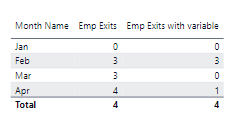- Power BI forums
- Updates
- News & Announcements
- Get Help with Power BI
- Desktop
- Service
- Report Server
- Power Query
- Mobile Apps
- Developer
- DAX Commands and Tips
- Custom Visuals Development Discussion
- Health and Life Sciences
- Power BI Spanish forums
- Translated Spanish Desktop
- Power Platform Integration - Better Together!
- Power Platform Integrations (Read-only)
- Power Platform and Dynamics 365 Integrations (Read-only)
- Training and Consulting
- Instructor Led Training
- Dashboard in a Day for Women, by Women
- Galleries
- Community Connections & How-To Videos
- COVID-19 Data Stories Gallery
- Themes Gallery
- Data Stories Gallery
- R Script Showcase
- Webinars and Video Gallery
- Quick Measures Gallery
- 2021 MSBizAppsSummit Gallery
- 2020 MSBizAppsSummit Gallery
- 2019 MSBizAppsSummit Gallery
- Events
- Ideas
- Custom Visuals Ideas
- Issues
- Issues
- Events
- Upcoming Events
- Community Blog
- Power BI Community Blog
- Custom Visuals Community Blog
- Community Support
- Community Accounts & Registration
- Using the Community
- Community Feedback
Register now to learn Fabric in free live sessions led by the best Microsoft experts. From Apr 16 to May 9, in English and Spanish.
- Power BI forums
- Forums
- Get Help with Power BI
- DAX Commands and Tips
- Re: Problem with DATESYTD
- Subscribe to RSS Feed
- Mark Topic as New
- Mark Topic as Read
- Float this Topic for Current User
- Bookmark
- Subscribe
- Printer Friendly Page
- Mark as New
- Bookmark
- Subscribe
- Mute
- Subscribe to RSS Feed
- Permalink
- Report Inappropriate Content
Calculate with and without variables difference
I have 2 calculate formulas:
Formula 1:

Solved! Go to Solution.
- Mark as New
- Bookmark
- Subscribe
- Mute
- Subscribe to RSS Feed
- Permalink
- Report Inappropriate Content
Hi @Anonymous
The measure
Emp Exits with variable =
VAR EmpExits =
SUM ( Emp_Exits[Employee Exits] )
RETURN
CALCULATE (
EmpExits,
Emp_Exits[MonthNo] <= MAX ( Emp_Exits[MonthNo] ),
ALL ( Emp_Exits[Month Name] )
)is exactly the same as
Emp Exits with variable =
SUM ( Emp_Exits[Employee Exits] )The reason is that variables are only evaluated once therefore cannot be recalculated as measures inside a CALCULATE statement. Thus only the value of the first measure is always returned.
- Mark as New
- Bookmark
- Subscribe
- Mute
- Subscribe to RSS Feed
- Permalink
- Report Inappropriate Content
Hi @Anonymous
The measure
Emp Exits with variable =
VAR EmpExits =
SUM ( Emp_Exits[Employee Exits] )
RETURN
CALCULATE (
EmpExits,
Emp_Exits[MonthNo] <= MAX ( Emp_Exits[MonthNo] ),
ALL ( Emp_Exits[Month Name] )
)is exactly the same as
Emp Exits with variable =
SUM ( Emp_Exits[Employee Exits] )The reason is that variables are only evaluated once therefore cannot be recalculated as measures inside a CALCULATE statement. Thus only the value of the first measure is always returned.
- Mark as New
- Bookmark
- Subscribe
- Mute
- Subscribe to RSS Feed
- Permalink
- Report Inappropriate Content
Hey,
Please try this one!!
- Mark as New
- Bookmark
- Subscribe
- Mute
- Subscribe to RSS Feed
- Permalink
- Report Inappropriate Content
The MonthName column is derived from Month column using formula FORMAT([Month],"MMM").
DATESYTD is working fine with Month but not working with MonthName column which is derived from Month column:
- Mark as New
- Bookmark
- Subscribe
- Mute
- Subscribe to RSS Feed
- Permalink
- Report Inappropriate Content
Try to create a seperate date table as shown below then apply your DAX accordingly.
Helpful resources

Microsoft Fabric Learn Together
Covering the world! 9:00-10:30 AM Sydney, 4:00-5:30 PM CET (Paris/Berlin), 7:00-8:30 PM Mexico City

Power BI Monthly Update - April 2024
Check out the April 2024 Power BI update to learn about new features.

| User | Count |
|---|---|
| 46 | |
| 27 | |
| 20 | |
| 12 | |
| 8 |
| User | Count |
|---|---|
| 75 | |
| 52 | |
| 46 | |
| 15 | |
| 12 |

